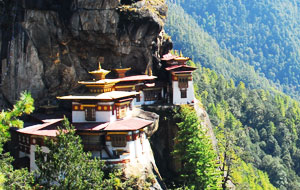Bhutan - land of monasteries, fortresses
The Buddhist Kingdom of Bhutan lies along the lofty ridges of the eastern Himalayas, bordered by China (Tibet) to the north and northwest, and by the Indian states of Arunachal Pradesh, Assam, West Bengal and Sikkim on the east, south and west respectively. With an area of 46,500 square km., Bhutan is comparable to Switzerland both in its size and topography. It was the mighty Himalayas which protected Bhutan from the rest of the world and left the Kingdom blissfully untouched through the centuries. The Drukpa Kagyupa school of Mahayana Buddhism provided the essence of a rich culture and a fascinating history. The Bhutanese people protected this sacred heritage and unique identity for centuries by choosing to remain shrouded in a jealously guarded isolation. The Kingdom is peopled sparsely, with a population of only 678,000. Four main linguistic groups constitute Bhutan's population: the Sharchopas, who are held to be indigenous inhabitants, the Bumthangpas and the Ngalongpas who originate in neighboring Tibet, and the Lhotshampas, recent immigrants of Nepalese origin. The inhabitants of Bhutan are gracious, gentle and very hospitable. They are peace loving and possess a lively sense of humor. The history of the Kingdom dates back to the 8th century, with Guru Padmasambava's legendary flight from Tibet to Bhutan in 747 A.D, on the back of a tigress. The Guru, also considered as the second Buddha, arrived in Taktsang (Tiger's Nest), on the cliffs above the valley of Paro, and from there began propagation of the Tantric form of Mahayana Buddhism. In the ensuing centuries many great masters preached the faith, resulting in the full bloom of Buddhism in the country by the middle ages. Although sectarian at first, the country was eventually unified under the Drukpa Kagyupa sect of Mahayana Buddhism in the early 17th century, by the religious figure, Shabdrung Ngawang Namgyal. The Shabdrung codified a comprehensive system of laws and built dzongs which guarded each valley during unsettled times, and nowadays serve as the religious and administrative centers of their respective regions. In the next two centuries, the nation was once again fragmented into regional fiefdoms with intermittent civil wars. At the end of the 19th century, the Tongsa Penlop, Ugyen Wangchuck, who then controlled the central and eastern regions, overcame all his rivals and united the nation once again. He was unanimously accepted as the first hereditary monarch of Bhutan in 1907. Bhutan is the only extant Mahayana Buddhist Kingdom in the world of today, and the teachings of this school of Buddhism are a living faith among its people. The air of spirituality is pervasive even in urban centers where the spinning of prayer wheels, the murmur of mantras and the glow of butter lamps are still commonplace features of everyday life. Bhutan's religious sites and institutions are not museums, but the daily refuge of the people. One of the most striking physical features of Bhutan is its architecture. The characteristic style and color of every building and house in the Kingdom is a distinct source of aesthetic pleasure. The dzongs - themselves imposing 17th century structures built on a grand scale without the help of any drawings and constructed entirely without nails - are outstanding examples of the best in Bhutanese architecture. Patterns of rich colors adorn walls, beams, pillars and doors in traditional splendor. As with its architecture, art and painting are important aspects of Bhutanese culture and they bear testimony to the spiritual depth of Bhutanese life. Whether it is on a wall, or one of the renowned thangkhas, painters use vegetable dyes to give their work an unparalleled subtle beauty and warmth. Bhutan also boasts a wealth of cottage industries, and the skills of its wood carvers, gold and silversmiths, and weavers (to name only a few) are all representative of highly developed art forms.
Places to visit in Bhutan
Phuentsholing
The gateway to the south, it is a thriving commercial center on the northern edge of the Indian plains. Situated directly at the base of the Himalayan foothills, Phuentsholing is a fascinating mixture of Indian and Bhutanese, Phuentsholing a perfect example of the mingling of peoples and cultures. Being a frontier town, Phuentsholing is a convenient entry/exit point for visiting Bhutan and also the neighboring Indian states of West Bengal, Sikkim and Assam.
Paro
This beautiful valley encapsulates a rich culture, scenic beauty and hundreds of myths and legends. It is home to many of Bhutan's oldest temples and monasteries, the country's only airport, and the National Museum. Mt. ParoChomolhari (7,300m) reigns in white glory at the northern end of the valley, its glacial waters plunging through deep gorges to form the Pa Chu (Paro River). The Paro valley is one of the Kingdom's most fertile, producing the bulk of Bhutan's famous red rice from its terraced fields.
Thimphu
The capital town of Bhutan, and the center of government, religion and Thimphucommerce, Thimphu is a lively place, an interesting combination of tradition and modernity. Home to civil servants, expatriates and the monk body, Thimphu maintains a strong national character in its architectural style.
Punakha
Punakha served as the capital of Bhutan until 1955 and still it is the winter seat of the Je Khenpo (Chief Abbot). Blessed with a temperate climate and fed by the Pho Chu (male) and Mo Chu (female) rivers, Punakha is the most fertile valley in the country. There are splendid views from Dochu-la pass (3, 088m/10,130ft) on the Thimphu - Punakha road.
Wangduephodrang
Located south of Punakha and the last town before central Bhutan, Wangduephodrang is like an extended village with a few well-provisioned shops. The higher reaches of the Wangduephodrang valley provide rich pastureland for cattle. This district is famous for its fine bamboo work, stone carvings, and slate which is mined up a valley a few km. from the town.
Tongsa
This town, perched on steep slopes above a river gorge, forms the central hub of the nation and is the place from where attempts at unifying the country were launched in former times. The landscape around Tongsa is spectacular and its impressive dzong, stretched along a ridge above a ravine, first comes into view about an hour before the winding, mountain road leads you into the town itself.
Bumthang
This lovely valley is the religious heartland of the nation and home to some of its oldest Buddhist temples and monasteries. Tales of Guru Padmasambhava and the tertons ('religious treasure-discoverers') still linger in this sacred region.
Tashigang
Tashigang lies in the far east of Bhutan, and is the country;s largest district. Tashigang town, on the hillside above the Gamri Chu (river), was once the center for a busy trade with Tibet. Today it is the junction of the east-west highway, with road connections to Samdrup Jongkhar and then into the Indian state of Assam. This town is also the principle market place for the semi-nomadic people of Merak and Sakteng, whose way of dress is unique in Bhutan.
Tashiyangtse
Tashiyangtse is a rapidly growing town and administrative center for this district. Situated in a small river valley, it is a lovely spot from which to take walks in the surrounding countryside. The dzong overlooking the town was built in the late 1990s when the new district was created. Tashiyangtse is famous for its wooden containers and bowls, which make inexpensive, attractive and useful mementos of a visit to this remote region. The Institute for Zorig Chusum, where students study the 13 traditional arts and crafts of Bhutan, is also worth a visit.
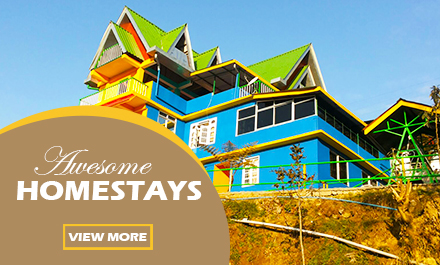
Exclusive packages for you
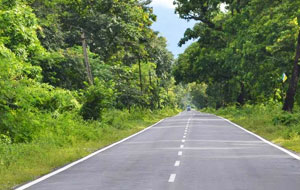
Jaldapara-Lataguri
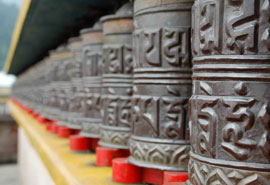
THE BEAUTIFUL SIKKIM
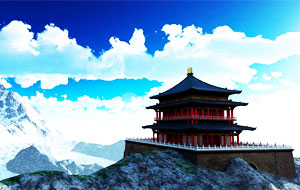
Phuentsholling- Paro
